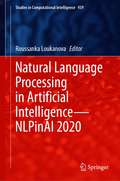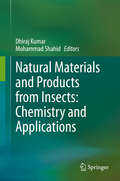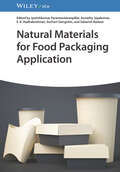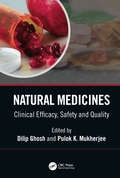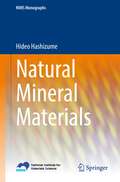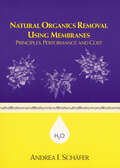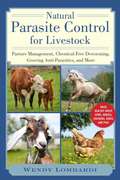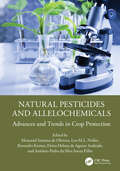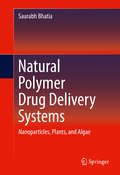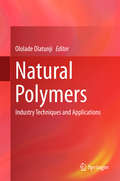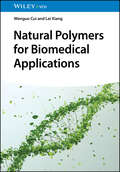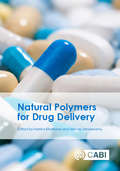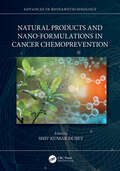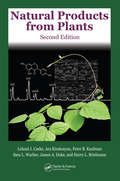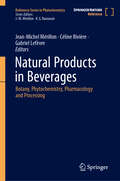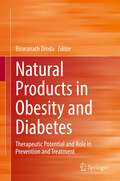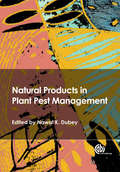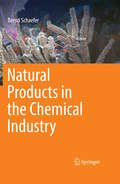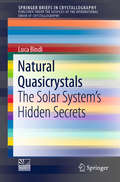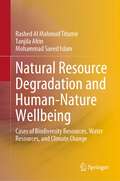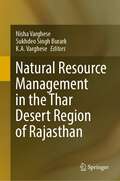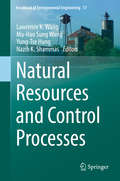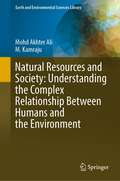- Table View
- List View
Natural Language Processing in Artificial Intelligence—NLPinAI 2020 (Studies in Computational Intelligence #939)
by Roussanka LoukanovaThis book covers theoretical work, applications, approaches, and techniques for computational models of information and its presentation by language (artificial, human, or natural in other ways). Computational and technological developments that incorporate natural language are proliferating. Adequate coverage encounters difficult problems related to ambiguities and dependency on context and agents (humans or computational systems). The goal is to promote computational systems of intelligent natural language processing and related models of computation, language, thought, mental states, reasoning, and other cognitive processes.
Natural Materials and Products from Insects: Chemistry and Applications
by Dhiraj Kumar Mohammad ShahidThis book reviews the latest research on bioproducts from various economically important insects, such as silkworms, honey bees, lac and drosophila, and termites, and discusses their general, biomedical and industrial applications in detail. It includes chapters focusing on insects as a food source, probiotics, silk-based biomaterials, insect pheromones, insects as biomedicine source, pupa oil chemistry, non-protein compounds from Lepidopteran insects, insect chitin and chitosan, polyphenols and flavonoids.Model insects like Bombyx mori or bees were domesticated in Asian countries thousands of years ago. Over time, natural products from these animals became industrialized and today they attracting increasing attention thanks to their sustainability and their manifold applications in agriculture and biomedicine. The book is intended for entomologists, material scientists, natural product researchers and biotechnologists.
Natural Materials for Food Packaging Application
by Jyotishkumar Parameswaranpillai; Aswathy Jayakumar; E. K. Radhakrishnan; Suchart Siengchin; Sabarish RadoorNatural Materials for Food Packaging Application Analyze the future of biodegradable food packaging with this cutting-edge overview Packaging plays an essential role in the production of food and its movement through the global supply chain. Food packaging has been a significant site of innovation recently, allowing consumers better access to natural and organic foods, extended shelf lives, and more. However, food packaging has become an increasingly serious environmental hazard, with the result that biodegradable food packaging has become a vital and growing area of research. Natural Materials for Food Packaging Application provides a thorough and detailed introduction to natural packaging and its applications in food transportation. Treating both recent innovations and prospective future developments, it provides readers with extensive insights into the current state of research in this field. The result is a volume designed to meet the aspirational needs of a sustainable food industry. Natural Materials for Food Packaging Application readers will also find: Detailed treatment of biodegradable packaging materials including thermo-plastic starch, polybutylene succinate, and more Discussion of subjects including chitosan-based food packaging films, clay-based packaging films, and more An authorial team with vast expertise in the field of biological polymer production Natural Materials for Food Packaging Applications is a useful reference for chemists, materials scientists, and food scientists, as well as for any industry professionals working in food distribution and the food supply chain.
Natural Medicines: Clinical Efficacy, Safety and Quality
by Dilip Ghosh Pulok K. MukherjeeGlobally, natural medicine has been considered as an important alternative to modern allopathic medicine. Although natural medicines are popular in society, only limited medicinal herbs have been scientifically evaluated for their potential in medical treatment. This book connects various aspects of the complex journey from traditional medicine to modern medicine. It provides information on topics including global regulations and regulatory hurdles, diverse nutritional challenges and potential health benefits, novel food innovations especially seed-to-clinic approaches, and future trends. FEATURES • Provides information on sustainable use of natural products in the development of new drugs and clinically validated herbal remedies • Discusses issues on evaluation and clinical aspects of herbal medicine, promotion and development, safety evaluation, metabolite profiling, biomarker analysis, formulation, and stability testing • Describes traditional uses of natural medicine through identification, isolation and structural characterization of their active components • Elucidates mechanisms of biological action, adverse effects and identification of their molecular targets of natural medicine • Multidisciplinary appeal including chemistry, pharmacology, pharmacognosy and cell and molecular biology, as well as integration with clinical medicine This book serves as an essential guide for individuals researching natural medicines, and industry employees in areas including drug development, pharmacology, natural products chemistry, clinical efficacy, ethnopharmacology, pharmacognosy, phytotherapy, phyto-technology and herbal science.
Natural Mineral Materials (NIMS Monographs)
by Hideo HashizumeThis book presents natural minerals used as inorganic materials, and inorganic materials exchanging cations or anions in natural minerals for other ions not found in nature. In addition, composites such as natural mineral materials that interact with organic molecules or polymers are introduced according to how they are used.Readers can refer to this volume as a guidebook to search for specific inorganic materials, and, if they wish, can consult any part of it at random. The book will be especially helpful and of interest to both scientists and engineers.
Natural Organics Removal Using Membranes: Principles, Performance, and Cost
by Andrea SchaferNatural Organics Removal Using Membranes: Principles, Performance, and Cost provides a unique combination of important new data and operational parameters on the role of membranes in removing natural organic materials during water treatment. It examines and compares the three pressure-driven membrane processes of choice-ultrafiltration, microfiltra
Natural Parasite Control for Livestock: Pasture Management, Chemical-Free Deworming, Growing Antiparasitics, and More
by Wendy LombardiEverything You Need to Know about Natural Parasite Control for Livestock, All in One Place! This concise book is loaded with valuable information about ridding livestock of their unwanted guests. Whether you're raising sheep, pigs, horses, cows, chickens, goats, or other farm animals, this book will teach you how to keep them healthy and parasite-free through organic systems and without the use of harsh chemicals. It includes easy-to-follow scientific explanations, and provides research-based practices that really work. Internal parasite control can be accomplished naturally 1) through environmental modifications, 2) by producing and using easy-to-grow & harvest anti-parasitics, and, 3) by understanding the life-cycles and road blocks of internal parasites. In this practical guide you will learn about: Parasites, hosts, and lifecyclesHow to develop a working pasture rotation systemHow to create healthy pastures and clean watering systemsAdministering natural antiparasiticsGrowing, collecting, and processing natural and herbal antiparasiticsAnd more! This is a necessary reference manual for all sustainable, natural, animal-husbandry endeavors!
Natural Pesticides and Allelochemicals: Advances and Trends in Crop Protection
by Mozaniel Santana de Oliveira Leo M.L. Nollet Ravendra Kumar Eloisa Helena de Aguiar Andrade Antônio Pedro da Silva Souza FilhoNatural pesticides and allelochemicals are used for protection against invasive plants, but when released into the environment they can have both positive and negative effects on plants. This book discusses a holistic and sustainable approach that balances effective pest management with minimizing environmental impacts, promoting biodiversity, and ensuring food safety and quality. It brings together proposals to help improve the quality of management and production of healthier foods utilizing compounds of natural origin. The authors provide a broad and diverse picture of the applications of terpenoids in plant safety and the possibilities for innovative biotechnological approaches for their extraction.Features: Presents a comprehensive resource on recent advances in natural pesticides and new allelochemicals for crop protection Discusses natural herbicides, sustainable agriculture, and bioeconomic processes Explains the challenges of synthetic pesticides and their costs to human and environmental health Covers different aspects of natural pesticides such as their sources, development, application, and toxicity Helps professionals and scholars involved in chemical technology, biotechnology, and agriculture gain a thorough understanding of crop protection practices tailored to specific crop types, regional conditions, and pest pressure This is a great reference for researchers, academics, students, and professionals involved with or interested in agriculture and the environment, pest control, environmental chemistry, biology, food science, and forest engineering.
Natural Polymer Drug Delivery Systems
by Saurabh BhatiaThis book describes 200 bio-polymers, including the most recent and advanced nanotechnology applications. The applications of various bio-medical and other future potential uses are covered and examined in depth. Systematic discussion of current leading natural polymers is also included.
Natural Polymers
by Ololade OlatunjiThis book introduces the most recent innovations in natural polymer applications in the food, construction, electronics, biomedical, pharmaceutical, and engineering industries. The authors provide perspectives from their respective range of industries covering classification, extraction, modification, and application of natural polymers from various sources in nature. They discuss the techniques used in analysis of natural polymers in various systems incorporating natural polymers as well as their intrinsic properties.
Natural Polymers for Biomedical Applications
by Wenguo Cui Lei XiangDevelop natural solutions to biomedical problems with this introduction A natural polymer is one that forms from biosynthetic or biochemical processes typically found in nature, with corresponding advantages in biocompatibility and biodegradability. These advantages give natural polymers a range of applications, from the use of polysaccharides as structural components to the use of polyphenols as antioxidant active ingredients. In biomedical engineering they are clearly preferable to synthetic polymers in numerous cases, and their applications are more numerous every day. Natural Polymers for Biomedical Applications offers a comprehensive summary of these polymers and their biomedical applications. It covers the sources, structures, and properties of polysaccharides, polyphenols, and polypeptides, as well as analyzing the latest advances in polymer-based biomedical technologies. The result has ramifications in a vast range of industries and research areas. In Natural Polymers for Biomedical Applications readers will also find: Applications including drug and cell delivery, cell and organoid cultures, tissue regeneration, and moreDetailed analysis of alginate, cellulose, quercetin, silk fibroin, and many othersA logical, easy-to-use structure to facilitate rapid access to pertinent information Natural Polymers for Biomedical Applications is ideal for materials scientists, polymer chemists, biochemists, and any researcher or professional in biomedical or pharmaceutical industries.
Natural Polymers for Drug Delivery
by Harsha Kharkwal Srinivas JanaswamyNatural polymers have been utilized extensively in food, pharmaceuticals, cosmetics, textiles, oil drilling and paint industries. Their non-toxic and inexpensive attributes readily enhance their commercial acceptability and make them potent agents in lieu of synthetic polymers. This book explores the opportunistic utility of natural polymers in developing effective drug delivery systems and provides a comprehensive and up-to-date analysis of their source, chemical structure and mechanism of action. Covering novel polymers for drug delivery - in particular extracts from plants, microorganisms and proteins, as well as water soluble and water insoluble biodegradable polymers - it presents an encyclopaedic overview of natural polymers': - quintessential roles in binding drugs towards enhancing bioavailability - modification and derivatization for targeted delivery - role as active drugs Natural Polymers for Drug Delivery is an invaluable resource for researchers, students and industrial scientists in the fields of biochemistry, chemistry, pharmacology and food science.
Natural Products and Nano-Formulations in Cancer Chemoprevention (Advances in Bionanotechnology)
by Shiv Kumar DubeyThis book covers various aspects of cancer chemoprevention, including an overview of chemoprevention in the process of tumorigenesis; the roles of various phytochemicals, functional foods, and dietary interventions in disease prevention; and techniques such as cancer stem cell targeting, nano-formulations, and so forth. The nutrigenomic and epigenetic effects of natural products at the molecular and genetic levels are also covered alongside their potential for additive and synergistic effect, as well as overcoming drug resistance. The key selling features of the book are as follows: Discusses holistic and comprehensive areas of chemoprevention Includes diverse techniques, such as cancer stem cell targeting, nano-formulations, and nanotechnology-based drug delivery systems Introduces various mechanisms involved in prevention of the diseases, including targeting cancer stem cells Reviews various aspects which can reduce the toxicity and cost of treatment of diseases by alternative medicine Explores various sources, mechanisms, and ways to develop cancer chemopreventive agents with minimal toxicity compared to traditional cancer therapy drugs This book is focused on researchers and graduate students in drug delivery and formulation, nanobiotechnology, cancer chemoprevention, prevention, and therapeutics.
Natural Products as Enzyme Inhibitors: An Industrial Perspective
by Vijay L. Maheshwari Ravindra H. PatilThis book provides an overview of the latest developments and future challenges in enzyme inhibitor research. It discusses the general enzyme inhibitory principles and mechanisms in enzyme activity regulation and application of enzyme inhibitors in different areas and sectors. The major areas of applications of enzyme inhibitors covered in this book are human health management, agriculture, food processing and research, which leads to drug discovery or enzyme activity mechanisms. The book also identifies the gaps in the existing knowledge and opens up new research ideas in this important area. Currently, most enzyme inhibitors are reported to inhibit various classes of enzymes. These enzyme inhibitors are the focus of the scientific community because they may answer an increasing array of questions in the research area of biological sciences, including biochemistry, medicine, physiology, pharmacy, agriculture, ecology etc. It also serves as a useful tool in the study of enzyme structures and reaction mechanisms and in the development of technologies in agriculture, food processing, and health management. Chapters in this book cover topics such as plant-derived inhibitors of serine proteases, pancreatic lipase (PL) inhibitors from indigenous medicinal plants, amylase inhibitors and their applications in agriculture and food processing industries and advances in silico techniques used in the study of enzyme inhibitors. The book will serve as a valuable resource for students and researchers in Life Sciences, agriculture, medicine, food processing, and allied industries.
Natural Products from Plants
by Leland J. Cseke Ara Kirakosyan Peter B. Kaufman Sara Warber James A. Duke Harry L. Brielmann2008 NOMINEEThe Council on Botanical and Horticultural Libraries Annual Award for a Significant Work in Botanical or Horticultural Literature From medicinal, industrial, and culinary uses to cutting-edge laboratory techniques in modern research and plant conservation strategies, Natural Products from Plants
Natural Products in Beverages: Botany, Phytochemistry, Pharmacology and Processing (Reference Series in Phytochemistry)
by Jean-Michel Mérillon Céline Rivière Gabriel LefèvreThis reference book provides an overview of the active ingredients of selected plants present in beverages. The book aims to highlight according to the chapters the botanical, ethnobotanical, ecological or agronomic aspects of these botanical species used in some well-known or rarer beverages by linking them to their phytochemistry. This book also covers the manufacturing techniques, as well as the quality control of these products of natural origin in beverages. The content is divided into five main sections containing chapters written by valuable experts in their field : (1) beverages plants with caffeine and other methylxanthines, (2) beverage plants without caffeine, (3) fruits juices, (4) alcoholic beverage plants: non-distilled beverages and (5) alcoholic beverage plants: distilled beverages. The book is a useful resource for graduate students, academics and researchers in the field of botany, agriculture, food chemistry, nutrition as well as for industrial scientists and those involved in the commercialization of phytochemicals, plants and their extracts.
Natural Products in Obesity and Diabetes: Therapeutic Potential and Role in Prevention and Treatment
by Biswanath DindaThis book provides a detailed summary of the therapeutic benefits of natural extracts from medicinal plants, mushrooms, algae, fungi and sponges and their role in the prevention and treatment of obesity and diabetes, offering readers a solid introduction to obesity and diabetes as well as current treatment models. In addition, it examines how genomics and multi-omics approaches have revolutionized our understanding of these diseases, and discusses the role of microbiome-host interactions, probiotics, prebiotics and the future of metabolic phenotyping.Focusing on the pharmacokinetics of anti-obesity and anti-diabetic phytochemicals, their bioavailability in the respective target tissues and their elimination times, the book also describes the nanoformulations of phytochemicals and herbal extracts. Lastly, it presents an overview of the advances in clinical studies on the use of herbal and mushroom extracts in obesity and diabetes management.Given its scope, this book is useful not only for researches in the field but also for students studying nutrition, food sciences, plant sciences or pharmacology, as well as for health professionals and practitioners.
Natural Products in Plant Pest Management
by Nawal K. DubeyThis book brings together the chemistry and biology of natural pesticides and discusses modern trends in their development and use in pest management.
Natural Products in the Chemical Industry
by Bernd SchaeferNatural Products in the Chemical Industry is not a conventional textbook, but rather an invitation to join an entertaining journey that takes you into the fascinating world of natural products. This book features diverse compound classes from a number of areas: colourants, fragrances and flavourings, amino acids, pharmaceuticals, hormones, vitamins and agrochemicals. Whether you are a teacher or a scholar, an undergraduate or graduate student, a professional chemist in industry or academia, or someone just interested in natural sciences, this book allows you to be inspired and entertained by facts and information along with enjoyable anecdotes, historical, economic, political, biological and social considerations. Experts in the field can have a pleasurable time cruising through captivating synthesis methods, which enable the generation of complex molecules on industrial scale.This book · deals with the manufacturing of larger quantities of complex molecules (asymmetric and heterocyclic compounds, polycyclic structures, macrocycles and small rings) · displays all reaction schemes in colour, which makes them easy to read · highlights aesthetics and elegance in modern industrial organic chemistry
Natural Quasicrystals: The Solar System’s Hidden Secrets (SpringerBriefs in Crystallography)
by Luca BindiThis book describes the discovery of quasicrystals (icosahedral and decagonal) in an extraterrestrial rock from the Koryak Mountains of Far Eastern Russia. After a decade-long search for a natural quasicrystal, this discovery opened a new avenue in mineralogy and crystallography that could lead to further discoveries in geoscience, astronomy, condensed matter physics, and materials engineering. For the first time, minerals have been discovered that violate the symmetry restrictions of conventional crystallography. The natural occurrence of such crystals was unexpected, involving previously unknown processes. The fact that the quasicrystals were found in a meteorite formed in the earliest moments of the solar system means these processes have been active for over 4.5 billion years and have influenced the composition of the first objects to condense around the Sun. Finding quasicrystals formed in these extreme environments also informed the longstanding debate concerning the stability and robustness of quasicrystals. Recent shock experiments lend support to the hypothesis that the extraterrestrial quasicrystals formed as a result of hypervelocity impacts between objects in the early Solar system, and that they are probably less rare in the Milky Way.
Natural Resource Degradation and Human-Nature Wellbeing: Cases of Biodiversity Resources, Water Resources, and Climate Change
by Rashed Al Titumir Tanjila Afrin Mohammad Saeed IslamThe book addresses the gaps in the body of knowledge from two grounds. Firstly, it adds value through explaining the dynamics of natural resource governance by focusing on the particular arenas of biodiversity resources, water resources and climate change in developing country context. Secondly, it critically scrutinizes the market-centric perspectives on one hand and combines political economy questions that are generally overlooked in discussions of current resource governance framework, on the other. It develops a new framework to examine the reasons behind the degradations of natural resources to offer sustainable solutions to the problems. It shows that the natural resources have been exploited beyond sustainable limits due to the structural rigidities, embedded in, and reproduced by, fragile institutions and unequal power-sharing arrangements under the market-centric economic system. The book formulates a new understanding of sustainability in case of usage and management of natural resources by incorporating the idea of human sociality. It highlights the importance of the well-being of nature, and human beings must go side by side; one without the other is not a sustainable option. The book contains key learnings for scholars and researchers working in the field of development studies who wish to gain a deeper understanding on the sustainable natural resource governance specifically in the contexts of developing countries. For policymakers and policy advocates, the book serves as the groundwork on policies regarding biodiversity resources, water resources, and climate change, specific to the context of developing countries, providing more relevant contents in terms of laying out justification for policy objectives.
Natural Resource Management in the Thar Desert Region of Rajasthan
by Nisha Varghese Sukhdeo Singh Burark K. A. VargheseThis book covers a wide range of issues related to the Thar Desert Region of Rajasthan from an integrated and sustainable development perspective. The chapters in this book cover regional and local issues which are discussed with reference to the past scenario, the present practices, and the future strategies. Some of the issues addressed in this book like arid agroforestry, livelihood, and multidimensional development give it a cutting edge over other related publications currently available in the market. The chapters are supported with relevant pictures which will help the reader to connect with the issues being discussed. This book is useful to students, civil services aspirants, researchers, environmentalists, geographers, and non-professionals who are interested in deserts and desert development.
Natural Resources and Control Processes
by Lawrence K. Wang Mu-Hao Sung Wang Yung-Tse Hung Nazih K. ShammasThis edited book has been designed to serve as a natural resources engineering reference book as well as a supplemental textbook. This volume is part of the Handbook of Environmental Engineering series, an incredible collection of methodologies that study the effects of pollution and waste in their three basic forms: gas, solid, and liquid. It complements two other books in the series including Environmental and Natural Resources Engineering and Integrated Natural Resources Management that serve as a basis for advanced study or specialized investigation of the theory and analysis of various natural resources systems. This book covers the management of many waste sources including those from agricultural livestock, deep-wells, industries manufacturing dyes, and municipal solid waste incinerators. The purpose of this book is to thoroughly prepare the reader for understanding the sources, treatment and control methods of toxic wastes shown to have harmful effects on the environment. Chapters provide information on some of the most innovative and ground-breaking advances in waste characterization, control, treatment and management from a panel of esteemed experts.
Natural Resources and Local Livelihoods in the Great Lakes Region of Africa
by An Ansoms Stefaan MarysseFragile but progressive post-conflict reconstruction has allowed for a new growth-oriented logic in the Great Lakes Region of Africa. However, the opportunities provided by economic development are not being equally distributed. A struggle exists between large-scale and local small-scale actors that is particularly prevalent in the rural environment, where the increasingly prevalent scramble for natural resources impacts heavily upon local livelihoods. This is occurring both in the agricultural sector and in the mineral sector. This book analyses the opportunities and constraints for local actors' participation in economic growth. The book first looks into the contemporary challenges with regard to land relations and local livelihoods in the Democratic Republic of the Congo (DRC), Burundi and Rwanda. It then goes on to consider the ambiguities that characterise the relationship between mining and development in the DRC. This book is essential reading for students, researchers and policy makers workingon rural development in Africa and those interested in understanding post-conflict reconstruction and the way in which local level dynamics relate to the broader political economy. "
Natural Resources and Society: Understanding the Complex Relationship Between Humans and the Environment (Earth and Environmental Sciences Library)
by Mohd Akhter Ali M. Kamraju"Natural Resources and Society: Understanding the Complex Relationship Between Humans and the Environment" is a study of the dynamic interplay between humans and the natural world. The book explores the complex relationship between human societies and the environment, examining how human actions can both impact and be influenced by natural resources.The book covers a broad range of topics, including the history of human resource use, the role of natural resources in economic development, and the environmental impacts of resource extraction and consumption. It also considers the social and cultural factors that shape human interactions with the natural world, and the challenges of sustainable resource management. Overall, the book provides a comprehensive overview of the relationship between humans and the environment, emphasizing the importance of understanding this relationship in order to develop more sustainable and equitable societies.
